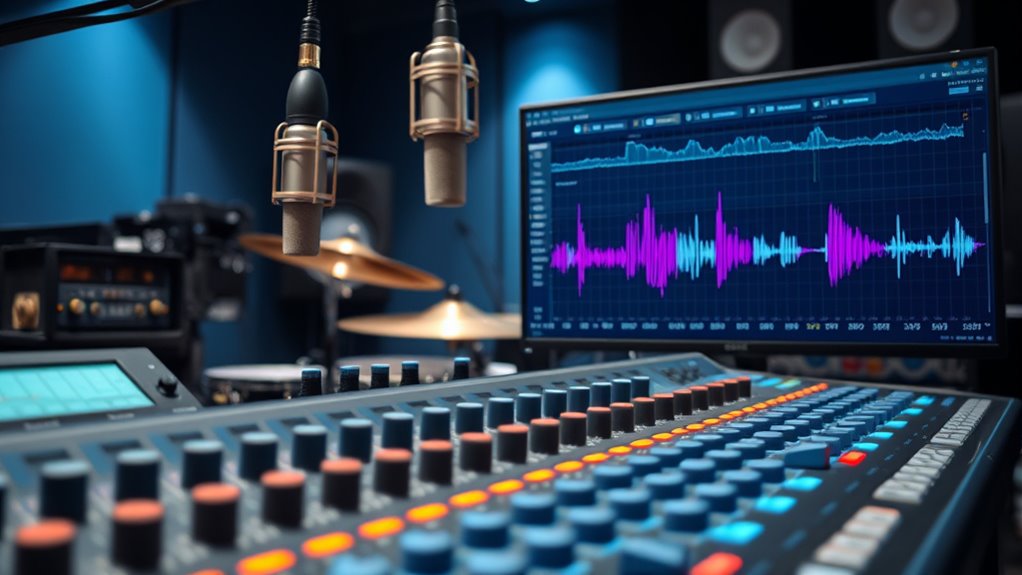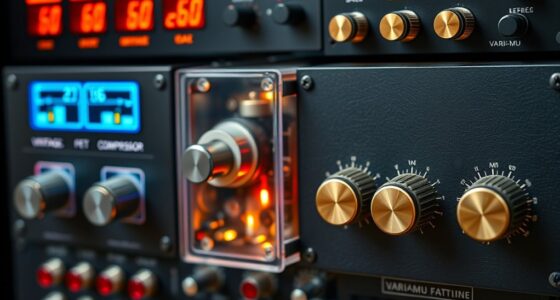To de-ess vocals and control cymbal harshness, focus on targeting specific high-frequency ranges—around 5-8kHz for sibilance and 10-15kHz for cymbals—using dynamic EQ or a dedicated de-esser. Use subtle adjustments and thresholds to only engage during problematic sounds, preserving natural tone. Balance is key—avoid over-processing to keep energy and clarity. If you continue exploring, you’ll discover effective techniques to achieve a polished, professional sound.
Key Takeaways
- Target the 5kHz–8kHz range for vocals and 10kHz–15kHz for cymbals using dynamic EQ or de-esser plugins.
- Set thresholds to activate only during problematic sibilant or harsh cymbal sounds for natural results.
- Apply subtle, precise reductions to avoid dulling the vocal tone or cymbal brightness.
- Use separate processing for vocals and cymbals to tailor the de-essing and preserve their natural qualities.
- Balance de-essing to maintain clarity and energy, preventing harshness while keeping the mix lively.

De-essing is a essential technique in audio production that helps tame harsh sibilant sounds like “s” and “sh,” making speech clearer and more pleasant to listen to. When working with vocals, vocal sibilance reduction becomes fundamental to prevent those sharp, piercing “s” sounds from dominating the mix. If you notice that certain words or phrases cause the vocal track to become overly sharp or sibilant, applying a de-esser can smooth out these frequencies without dulling the overall tone. The key is to target the specific frequency range where sibilance occurs, usually between 5kHz and 8kHz, and reduce it subtly enough to maintain naturalness. Using a dedicated de-esser plugin or dynamic EQ, you can set thresholds that activate only when sibilant sounds reach problematic levels. This way, you preserve the clarity of the vocal performance while controlling harshness. Additionally, understanding the importance of precise frequency targeting can help you achieve more transparent results from sound design techniques.
Cymbal harshness control is another pivotal aspect of de-essing that often gets overlooked. Cymbals, especially hi-hats and crashes, can produce aggressive high-frequency content that, if left unchecked, can make a mix feel overly bright or fatiguing. To tame cymbal harshness, you need to focus on the same core principle as vocal sibilance reduction—target specific high-frequency ranges with a dynamic processor. A de-esser or dynamic EQ set to control around 10kHz to 15kHz can help smooth out those piercing cymbal crashes and shimmer. Be cautious not to overdo it; you want to tame the harshness without stripping away the brightness and energy that cymbals bring to the mix. Often, subtle adjustments can make a significant difference, giving your cymbals a more balanced, polished sound.
In both cases, the secret lies in precise frequency targeting and dynamic control. Instead of applying broad EQ cuts, focus on dynamic tools that respond only when the problematic sounds are present. This approach ensures your vocals remain lively and expressive, and your cymbals retain their sparkle without becoming shrill or abrasive. Whether you’re working on a vocal track or a drum overhead, de-essing techniques should be subtle yet effective, enhancing clarity and listening comfort. By mastering vocal sibilance reduction and cymbal harshness control, you create a more professional, polished mix that’s easier for your audience to enjoy.
Frequently Asked Questions
Can De-Essing Affect the Overall Vocal Tone?
Yes, de-essing can affect your overall vocal tone. When you reduce sibilance, you might unintentionally alter the harmonic balance, making your voice sound less natural or more subdued. To avoid this, you should focus on precise vocal tone modification, ensuring you only target harsh sibilant frequencies. Proper de-essing preserves clarity without sacrificing warmth, helping your vocal performance sit well within the mix.
What Are the Best Plugins for De-Essing Vocals?
The best plugins for de-essing vocals are those that offer precise vocal sibilance control, allowing you to target harsh “s” sounds without dulling the voice. Plugins like FabFilter Pro-DS, Waves Sibilance, and iZotope Nectar are popular choices. When selecting a plugin, follow guidelines like ease of use, transparency, and the ability to adjust the threshold and frequency range, ensuring you maintain natural vocal tone while reducing sibilance effectively.
How Do I De-Ess Cymbals Without Losing Brightness?
To de-ess cymbals without losing brightness, focus on precise frequency control using a dynamic EQ or multiband compressor. Target the specific harsh frequencies around 5-10 kHz that cause sibilance, then gently reduce their dynamic range. This way, you tame the harshness while preserving the cymbals’ natural shimmer. Adjust the attack and release settings to avoid dulling the overall brightness, maintaining clarity and sparkle in your mix.
Should De-Essing Be Done During Recording or Mixing?
You should de-ess during mixing, as recording timing limits your options. Using mixing techniques gives you more control over sibilance and brightness without affecting the natural sound of vocals or cymbals. Applying de-essing during mixing allows you to fine-tune the process, ensuring clarity while preserving brightness. This flexibility helps you achieve a balanced, professional sound without compromising the overall tone of your recordings.
Can De-Essing Cause Phase Issues in a Mix?
Did you know that improper de-essing can lead to up to 20% phase cancellation? Yes, it can cause phase issues in your mix, especially with stereo imaging. When you overuse de-essing, it might alter the phase relationship between channels, resulting in a hollow or unfocused sound. To avoid this, carefully apply de-essing and monitor your stereo image to maintain clarity and avoid unintended phase problems.
Conclusion
Now that you’ve explored various de-essing strategies, you’re ready to tame harsh sibilants like a skilled gardener pruning a wild bush. Remember, subtlety is key—overdoing it can make your vocals and cymbals sound dull, like a painting washed out by too much water. Experiment with different techniques, trust your ears, and adjust until everything sounds smooth and balanced. With practice, you’ll make your mixes shine brighter than a starry night, free of harshness.









